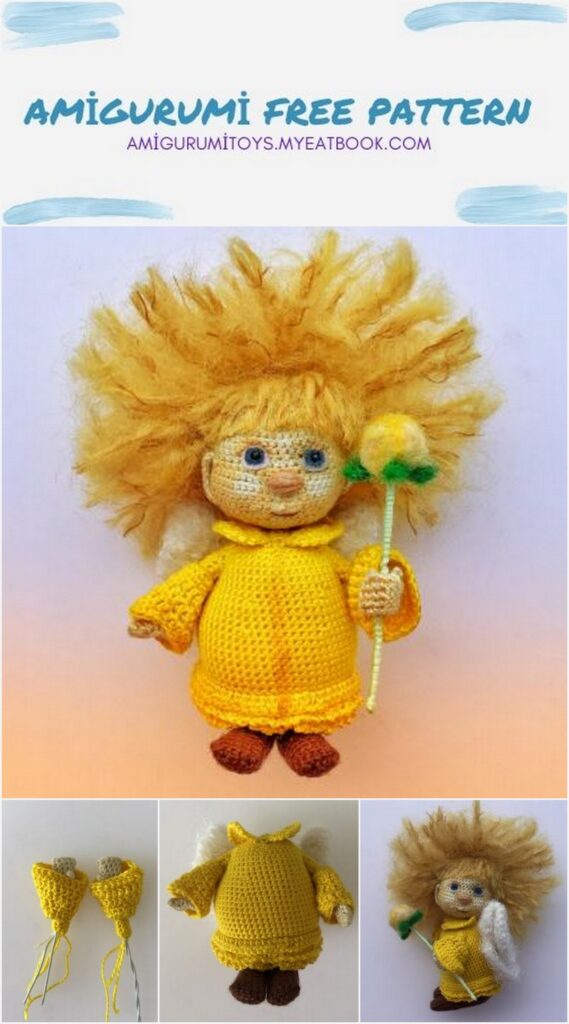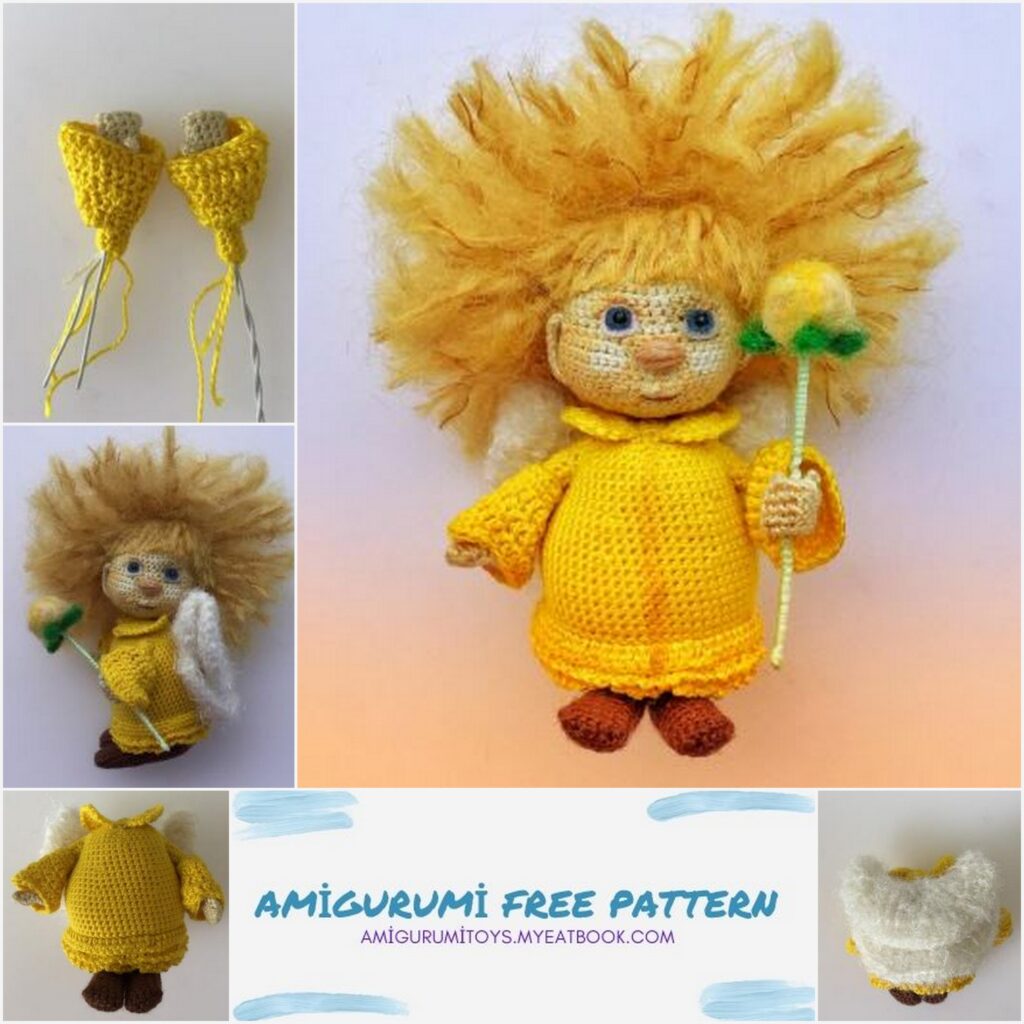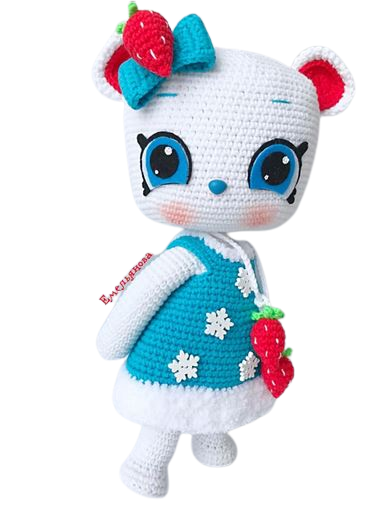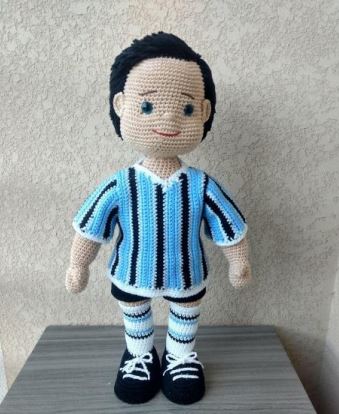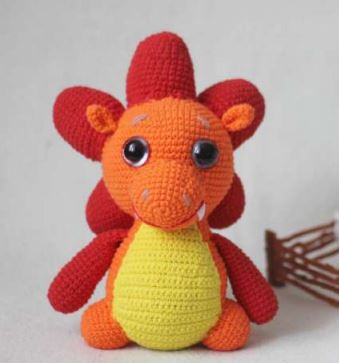Amigurumi Angel of Health Free pattern
Dandelion angel or good health angel
It is necessary to knit for both walls of the loops, unless otherwise indicated, in a spiral. Make sure that the number of loops in a row coincides with the number indicated in brackets at the end of the row. A video on knitting an angel of luck may also be useful, the head, head and hands, hands are knitted similarly.
Materials and tools used:
Head, hands, clothes, shoes:
1) For the body, you can use any thread of a suitable flesh color, I used Cotton “Iris” Gamma 100% mercerized, 10g = 87m. Hook 1.0 mm. The height of the angel turned out to be 10 cm.
2) For clothes and shoes – the same yarn (or similar thickness) as for the body, but in a different color. I AM I also used Cotton “Iris” Gamma 10g = 87m, yellow and brown.
3) Filler; weighting agent – optional (I have a coin).
4) Wire with a cross section of 0.55 mm or any other suitable. 2 pieces of 13-15 cm, for hands.
5) Scissors, pliers.
To decorate the doll’s face and hair:
1) For painted eyes and face: a small piece of white felt or any thin white cloth, paint acrylic, fine brush. Eyes can be embroidered, welded, etc. – optional.
2) Transparent glue (NOT superglue) for gluing the peephole. I have a crystal moment.
3) For hair – any shaggy thread of a suitable color (I have a special yarn for doll hair).
For the wings:
For the wings, you can use any shaggy white yarn, 2 times thicker than the main yarn (I have Adelia Valery 001, 50g = 146m), hook 2.0mm.
For a dandelion: I just rolled a ball of wool for felting, and rolled green leaves on it. I wrapped the wire with green thread and glued the dandelion on top. Make a dandelion your way desire. At the end of the master class, you will find an MK on dandelion from foamiana.
Legend:
Ch – air loop
Sc – single crochet
Dec – decrease (one column of two loops)
İnc – increase (2 columns from one loop)
Sl-st – connecting post
Dc – double crochet
Hdc – half double crochet
MR – amigurumi ring
(X, X) – when specifying any abbreviations in brackets – tie in one loop.
I knit inside out, but you can also knit the front side. Photos are given for the wrong side and the corresponding notes are made
for knitting the front.
For convenience, when knitting in one wall of the loops, I use the terms “outside” and “inside” wall.
Not to clarify, “front” and “back” for knitting the front or seamy side (they differ).
The “outer” wall is the one that “looks” outward of the product, and the inner one, accordingly, “looks” inside.
Head, bodily thread.
It is necessary to use a contrasting thread as the end of the row and make sure that the end of the row is strictly in a straight line, perpendicular to the knitted rows. In case of displacement of the end of the row – knit extra offset loops. Otherwise, the face will be asymmetrical.
1.MR of 6 Sc (6)
2.Inc * 6 times (12)
3. (İnc, Sc) * 6 times (18)
4. (Sc, İnc, Sc) * 6 times (24)
5. (İnc, 3 Sc) * 6 times (30)
6. (2 Sc, İnc, 2 Sc) * 6 times (36)
7. (İnc, 5 Sc) * 6 times (42)
8. (3 Sc, İnc, 3 Sc) * 6 times (48)
9-11. 3 rows of 48 Sc
12.18 Sc, 2 Dec, 2 Sc, 2 Sc, 2 Dec, 18 Sc (44)
13.21 Sc, 2 İnc, 21 Sc (46)
14.46 Sc
15.15 Sc, (İnc, Sc) * 4 times, (Sc, İnc) * 4 times, 15 Sc (54)
16.54 Sc
17.25 Sc, 2 Dec, 25 Sc (52)
18.25 Sc, behind the outer walls of the previous row: (Sc, Hdc) – in one loop, (Hdc, Sc) – in one loop (this there will be a mouth), for both walls – 25 Sc (54)
19. (3 Sc, Dec, 4 Sc) * 2 times, 3 Sc, Dec, 2 Sc (do not knit 4 loops of the 18th row!), For the remaining inner walls of the 17th row: İnc, İnc, for both walls – 2 Sc, Dec, 3 Sc, (4 Sc, Dec, 3 Sc) * 2 times (48)
20. (3 Sc, Dec, 3 Sc) * 6 times (42)
21.42 Sc
22. (Dec, 5 Sc) * 6 times (36)
23. (2 Sc, Dec, 2 Sc) * 6 times (30)
24. (Dec, 3 Sc) * 6 times (24)
25. (Sc, Dec, Sc) * 6 times (18)
Stuff your head tightly, symmetrically about the center, paying special attention to the cheek area.
26. (Dec, Sc) * 6 times (12)
27. Dec * 6 times (6)
Add filler, pull the hole, leave a long tip for the ears and nose (about 80 cm), thread trim. Count 10 loops to the side from the corner of the mouth and pull the thread there.
Tie first row of ear Sc in pattern, twist; second row: Sc in each loop.
Nose: count 3 rows up from the mouth, visually find the hole between the loops, located in the center.
Move 2 loops towards the ear, bring the thread into this place. Insert a hook into the same hole and remove through 2 loops from the center towards the other ear. Total distance is 4 loops. Grab and pull the thread.
Repeat this action several times (I did 14 times). Thus, quite wide and large nose.
Withdraw the nit through 10 columns on the other side of the corner of the mouth and tie the ear symmetrically.
Cut the thread, fasten it, hide it inside the head.
Ear diagram, front and side views:
Hair.
Try on yarn for the doll and cut one strand of the desired length.
Cut 50-100 hairs. The amount depends on the thickness of the yarn used. Later if needed cut some more.
When using thick yarn, it can be fastened with 2, 3 or 4 loops
We attach a thread to the head as follows:
1) enter in the right placem hook and output through the loop.
2) grab the thread in the middle and pull it out about a centimeter.
3) We grab both ends of the thread and pull it into a loop on the hook.
4) We tighten.
Start attaching the hair from the top of the head, in the place where the knitting of the head began.
Attach in a line from ear to ear.
Fill in the back of the head.
By the frequency of attachment, be guided by the thickness of the hair – the thicker, the less often you attach.
After attaching all the hair, I trimmed the front hair and lowered it to my eyes, giving the appearance of bangs (slightly glued, otherwise they bristled).
Face Shaping.
Eyes can be made in any way that you like – knit ready-made eyes, blind from plastic, embroider, felted, knit, etc. I draw eyes, therefore, I will describe this method. I use acrylic paints.
Cut 2 parts from thin felt or any white fabric for future eyes (the size depends on the size head, be guided by the photo).
Draw an iris with blue acrylic paint, inside a black pupil, put a white highlight. After after drying, stick to the head in the area of the eyes (places with decreases on the head will serve as a clue).
Draw a brown red strip along the edge of the “mouth” loops.
Then I diluted the brown paint with water (so that it was dim) and ran a brush over my nose, slightly drew eyebrows. The water will then dry out, but the paint will remain, and will not be bright.
With the same diluted paint, I tinted the cheeks and chin.
Then I made the cheeks with diluted white paint.
You can tint your face in any usual way – with oil pastels, pencils, etc.
Hands, body thread (2 pcs.)
When knitting hands, displacement loops do not need to be done, it is only necessary to monitor the number of loops in row (to match the specified amount in brackets).
First hand (bodily thread):
1.4 Ch + Ch lifts from 2nd loop from hook 3 Sc, 3 Sc into 1 loop, 3 Sc (9)
2-4. Work 3 rows of 9 Sc.
5.3 Ch, 2 Sc along Ch, starting at 2nd loop from hook (thumb), 9 Sc
6.Dec, 7 Sc (8)
7-12. Work 6 rows of 8 sc.
13. Change the thread to the color of the garment (mine is yellow), starting with the next loop, 8 Sc.
From a piece of thin wire about 13 cm to make a frame for the hand – bend it in half, forming at the end a loop, the size of the palm. Insert inside.
14. 8 Sc behind the inner walls of the previous row.
15-18. 4 rows of 8 Sc, for both sts.
Fasten the thread, cut.
1. Join with a yellow thread to the left outer walls (to the loop along the line of the finger), knit (İnc, Sc) * 4 times (12)
2.3 Sc, 2 Dc, (Dc, Dc), (Dc, Dc), 2 Dc, 3 Sc (14)
3.3 Sc, 3 Dc, (Dc, Dc), (Dc, Dc), 3 Dc, 3 Sc (16)
4.7 Dc, (Dc, Dc), (Dc, Dc), 7 Dc (18)
5.8 Dc, (Dc, Dc), (Dc, Dc), 8 Dc (20)
6.9 Dc, (Dc, Dc), (Dc, Dc), 9 Dc (22)
Knit Sc, Sl-st (to straighten), cut the thread, pass the tip between the posts and tuck in hands.
Second hand:
When knitting the second hand before knitting a finger
knit an additional 1 Sc so that the finger is on the other
side and one hand will become left, the other right.
Body, yellow thread.
When knitting the body, there is no need to make additional displacement loops, you only need to monitor the number of loops in a row (to matches the specified amount in parentheses).
1.MR of 6 Sc (6)
2.Inc * 6 times (12)
3. (İnc, Sc) * 6 times (18)
4. (Sc, İnc, Sc) * 6 times (24)
5. (İnc, 3 Sc) * 6 times (30)
6. (2 Sc, İnc, 2 Sc) * 6 times (36)
7. (İnc, 5 Sc) * 6 times (42)
8.42 Sc behind the front walls of the loops (if knitting with the wrong side, behind the back walls of the loops, if knitting. designations will be “internal” or “external” walls of the loops, so as not to specify the method of knitting (front or wrong side)).
9. (İnc, 6 Sc) * 6 times (48)
10.48 Sc for inner walls
11. (İnc, 7 Sc) * 6 times (54)
12.54 Sc for the inner walls
13. (İnc, 8 Sc) * 6 times (60)
14.60 Sc for the inner walls loops
15-21. 7 rows of 60 Sc
22. (Dec, 8 Sc) * 6 times (54)
23-25. 3 rows of 54 Sc
26. (Dec, 7 Sc) * 6 times (48)
27-28. 2 rows of 48 Sc
29. Tie 4 Sc, knitting both body loops and arm loops (position the arm correctly, finger forward), 20 Sc, 4 Sc, knitting at the same time the loops of the body and the loops of the hand (place the hand right, with your finger in the same direction), 20 Sc (48)
30.4 Sc arm, 20 Sc, 4 Sc arm, 20 Sc (48)
Twist the wires from the hands together, and roll the ends, forming a ball. Hide inside the body.
Stuff the body with filler.
On the “bottom” of the body, I put a coin of a suitable diameter (for weight and shape). Stuff the body.
31. (3 Sc, Dec, 3 Sc) * 6 times (42)
32. (Dec, 5 Sc) * 6 times (36)
33. (2 Sc, Dec, 2 Sc) * 6 times (30)
34. (Dec, 3 Sc) * 6 times (24)
35. (Sc, Dec, Sc) * 6 times (18)
36. (Dec, Sc) * 6 times (12)
37. Dec * 6 times (6)
Pull the hole, cut the thread.
Return to the walls left at the beginning of knitting the body.
Attach thread to the top (last) row with the left walls. Knit Dc in a circle, cut the thread, fasten, hide.
Attach the thread to the 2nd row of the left loop walls, knit (Dc, Ch) – in a circle, cut the thread, fasten, hide.
Attach the thread to the 3rd row of the left loop walls (neither row), knit (Dc, Ch) – in a circle, cut the thread, fasten, hide.
Collar: (2 pieces), yellow thread.
9Ch + 3 Ch lifting 9 Dc, starting at 4 from hook, turn + 3 lifting loops Starting from the first column previous row 4 Dc, (Dc, Dc), (Dc, Dc), 4 Dc (12), thread fasten and trim, leaving long ends for sewing.
Sew on top of the body, as in the photo.
Shoes (2 pcs.):
6 Ch, from the second loop from the hook: 4 Sc, 3 Sc in 1 loop, 4 Sc, Sc in 6th loop chains (12)
19 rows of 12 Sc, fill lightly.
Connect two walls by knitting 5-6 Sc (starting chain and these columns should be parallel),
cut the thread, fasten, leave threads for sewing.
Sew on the bottom of the angel’s body.
Wings (white fluffy thread, 2 times thicker, hook 2.0 mm)
8 Dc in the amigurumi ring
İnc from Dc * 8 times (16)
İnc from Dc * 16 times (32)
Try it on. If necessary, knit another row or more in the same way. Fasten and cut the thread.
Fold in half, sew in the middle of the back (I sewed with a hook left from the tip knitting of wings, along the line of the spine).
Sew the head to the body.
Make your own dandelion. Mine is made of wire and felt.
Foamiana dandelion master class:
Congratulations, your angel of good health is ready!
